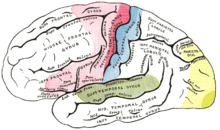Soul blindness

| Classification according to ICD-10 | |
|---|---|
| R48.1 | Agnosia |
| ICD-10 online (WHO version 2019) | |
Soul blindness (also known as visual agnosia or optical agnosia ) is a disorder in the processing of visual stimuli by the brain , which means that people are unable to recognize objects or faces even though they can see them. The cause of this is damage to the visual center in the occipital lobe .
The individual symptoms can vary depending on the exact cause and location of the damage. For example, some of those affected cannot draw pictures, but otherwise handle objects very skillfully. Typically, patients can describe objects in great detail (e.g. according to color, shape and texture of the surface), but are not able to recognize or name them. The description of known objects from memory is often not a problem either. In the case of special facial blindness, one speaks of prosopagnosia . The opposite of hearing is deafness .
Origin of the term
The term soul blindness comes from a first communication in 1877 from Hermann Munk , who surgically removed the visual cortex in dogs. Although they behaved superficially as if they were blind, that is, they could no longer see things visually, but they still reacted to visual stimuli. A publication on the subject of "soul blindness" in humans was published in 1886 by Hermann Wilbrand . In 1890 Heinrich Lissauer also described a disturbance of the visual system in humans due to a case he examined, his patient Gottlieb L.
In fact, it immediately emerged that the man who otherwise gave reasonable information about everything was unable to recognize a large part of the most common sensual objects by means of the visual sense. However, he recognized and described everything correctly that he could touch with his hands or perceive with his hearing. The patient can see. "
Lissauer proposed two different types of soul blindness: apperceptive soul blindness and associative soul blindness:
- Apperceptive soul blindness occurs due to damage to the early visual areas and prevents object recognition due to the inability to combine the various elements of visual perception into a coherent whole (Lissauer called this an "imagination").
- Associative soul blindness, on the other hand, occurs when the “imagination” cannot be brought together with the information and perceptions of other modalities to create a pre-linguistic representation of the object.
The term "agnostic" or "agnosia", which is mostly used today instead of soul blindness, was introduced by Sigmund Freud in 1891 , who understood it to mean more neuropsychological disorders of the visual system in the broader sense than just soul blindness. In the Freudian sense, agnosia includes cortical blindness and optical aphasia in addition to soul blindness . Nevertheless, the term (visual) agnosia is used today for soul blindness with the Lisauerian subcategories.
Meaning of soul blindness
As with many neurological disorders, a detailed examination of the clinical picture not only contributes to researching the disease itself, but also to a better understanding of the corresponding process in the healthy brain - in this case the visual process.
Studies in stroke patients and in monkeys have shown that the visual perception apparatus consists of two specialized systems. After the basic processing of visual stimuli in the primary visual cortex, the processing pathways are divided into a parietal (along the vertex centrally forward) and a temporal (directed towards the temple) processing stream. These have different functions. According to Mishkin and Ungerleider, the processing stream directed towards the temples is primarily used for object recognition (hence also called what stream ), while the processing stream running along the vertex is used to determine movement and distance (hence also called where stream ). This view has been challenged by Milner and Goodale. Due to a double dissociation of patients with visual apraxia , which identify one hand objects, but can not access targeted, and take the other hand, patients with visual Formagnosie (a particularly severe form of apperceptive agnosia), the objects, but may not realize Milner have and Goodale proposed a now generally accepted reinterpretation of processing streams. The stream oriented towards the temple is still seen as responsible for object recognition, but the stream oriented towards the vertex is no longer seen as processing spatial information, but rather as necessary for visuomotor skills (i.e. the action current ).
Individual evidence
- ↑ Alphabetical index for the ICD-10-WHO version 2019, volume 3. German Institute for Medical Documentation and Information (DIMDI), Cologne, 2019, p. 796
- ↑ Hermann Munk : Experiences in favor of localization. In: About the functions of the cerebral cortex. Collected communications. August Hirschwald, Berlin 1890. (First communication March 23, 1877)
- ↑ Hermann Wilbrand : The blindness of the soul as a hearth phenomenon and its relationship to homonymous hemianopsia, to alexia and agraphia . Wiesbaden 1886.
- ^ Heinrich Lissauer : A case of soul blindness together with a contribution to the theory of the same. In: Arch Psychiatr Nervenkr. 21, 1890, pp. 222-270.
- ↑ Sigmund Freud : On the conception of aphasia - a critical study. Deuticke, Vienna / Leipzig 1891.
- ^ LG Ungerleider, M. Mishkin: Two cortical visual systems. In: DJ Ingle, MA Goodale (Ed.): Analysis of Visual Behavior . MIT Press, Cambridge, Massachusetts, 1982, pp. 549-585.
- ^ MA Goodale, AD Milner, LS Jakobson, DP Carey: A neurological dissociation between perceiving objects and grasping them. In: Nature. 349, 1991, pp. 154-156.
